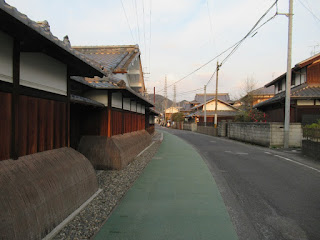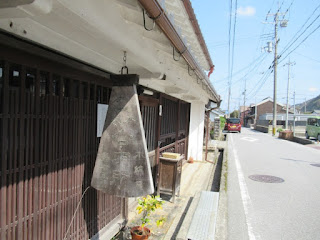I
resumed my Nakasendo Walk after 3-year halt due to the Covid-19 pandemic. My
last walk was in May, 2019.
Today,
I walked from Toriimoto, the 63rd shukuba station from Nihonbashi in
Tokyo, to Echigawa, the 65th station. Today’s walk was about 16 km.
Toriimoto
is in Hikone City, Shiga Prefecture. There are many Edo period-style buildings
preserved here.
They
include old style drug store.
Toriimoto’s
paper-made raincoats were famous in the Edo period. The signboard was preserved
at a store.
One
of traditional house was used as an elderly care service station.
The
tourist information in the town, such as information boards and exhibitions in a tourist center, is much better now
than four years ago, when I visited here last time. I was glad of the
improvement.
I
walked southward. Nakasendo runs through a flat place between Lake Biwa in the
west and the Suzuka mountains in the east. Nakasendo, the Shinkansen Line and
Meishinexpressway run in parallel.
I
found statues of Jizo, a Buddhist guardina deity of children, in many places
during my walk. (See the 2nd photo)
Takamiya,
the 64th station, is also in Hikone City. It was one of the largest shukuba
stations in Nakasendo in the Edo era.
Old-style
buildings are well preserved in Takamiys, too.
A
big gate of Taga-taisha shrine stands in at the center of the shukuba
street. Taga-taisha is the biggest shrine in Shiga Prefecture.
Takamiya
was famous for its trade of linen fabric in the Edo era. One of trader’s house
is now used as a tourist center.
A
lantern shop in Edo period-style is open near the big gate. (See th 3rd photo)
I
passed the “Muchin (free charge) Bridge” on the Inukami River when I left
Takamiya station. Cherry blossom in the river banks were beautiful.
I
continued walking. Agricultural fields spread on both sides of Nakasendo in
some parts.
The
Suzuka mountains were beautiful.
I
found cherry blossom behind a wheat field (See the top photo).
I
passed Toyosato Town before arriving in Echigawa station. The birthplace of
famous merchants Ito Chubei 1st and 2nd – father was active in the Meiji to
Taisho period; son in the Showa period – is preserved at the side of Nakasendo.
Omi,
or Shiga prefecture in current name, was historically famous for producing many
famous merchants.
Echigawa
is in Aisho Town. It is also famous as a hometown of many famous merchants,
including Yasujiro Tsutsumi.
Two
gates in both sides of the station welcome tourists.
I finished today's walk at Gokasho, aout 3km from Echigawa.




























































